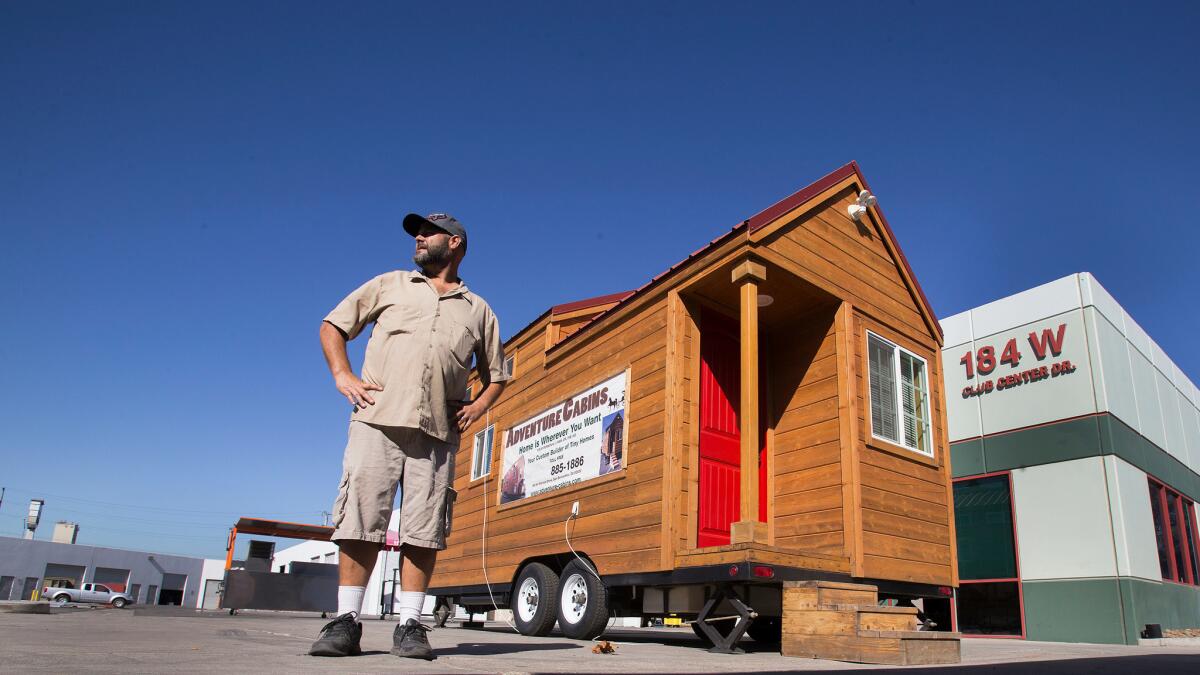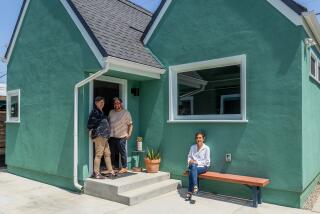Tiny homes are all the rage. But here’s why the market is more bust than boom

Builders have trouble tapping the tiny-home craze. Now they are scrambling for other ways to build and sell small living spaces without violating zoning restrictions and other laws.
- Share via
After hearing all the hype about tiny homes — the TV shows, lifestyle websites and magazine photo spreads — Lee Saenz decided that building the dinky dwellings would make a great part of his second career.
He formed a company called Adventure Cabins and began building little houses with rustic pine exteriors and state-of-the-art interiors. All that was left, Saenz believed, was for viewers of shows like HGTV’s “Tiny House Hunters” to beat a path to his San Bernardino workshop.
But after five years in business, Saenz has sold only five cabins. Two sit ready to go, with one marked down from $50,000 to just $29,000.
“There are so many roadblocks out there to selling them,” said Saenz, 75. “If they want to buy it, they don’t have the land. If they have the land, it’s not zoned for a tiny home. Or they don’t have enough cash.”
At first glance, the tiny home movement seems like a perfect multipurpose solution. Often priced at $50,000 or lower, they could be affordable to millennials burdened with student debt and baby boomers with skimpy retirement savings.

Tiny homes usually range from 100 square feet to 400 square feet, but they can be as small as 80 square feet (think garden shed) or as large as 700 square feet (roughly a three-car garage). Home shoppers concerned about climate change like that lighting, heating and cooling a tiny house has a minimal impact compared to a more typical 2,000-square-foot house.
But getting there is the difficult part. It’s not a bust, but there is certainly no boom as far as many builders are concerned.
Tiny homes, according to a 2015 analysis by the Pew Charitable Trust, are “cheap and energy efficient,” but “lost in the enthusiasm is the fact that in many places, it is hard to live in them legally.”
Finding land is difficult, particularly in densely developed communities with strict zoning laws on the number and size of units allowed. Vacant land must be carefully investigated for back taxes and liens. In places like drought-stricken California, there can also be building moratoriums.
Insurance is another complication since the trusted companies able to obtain it with relative ease are often RV builders.
Financing, typically one of the least fun experiences of buying a regular home, can be even more problematic. Some tiny home builders offer it, but many do not.
Saenz has no trouble getting customers financed in his primary business making food carts, industrial grills and portable sinks. But “I haven’t been able to find it for the cabins,” he said.
Most difficult of all, experts say, are laws in many cities and counties that mandate new single-family homes must be at least 1,000 square feet in size.
Many tiny homes are built on trailers, but that mobility can run afoul of local government restrictions on overnight parking or “camping” on one’s own land for more than 30 days. Even in some places where indefinite camping is allowed, it can be rare to be allowed to install utilities.
Tiny Smart House in Albany, Ore., could deliver a house a month if anyone wanted one, said office manager and designer Sarah Maisel. In five years, the company has sold just over two dozen tiny homes, supplemented with a line of food carts.
One recent client was so enthusiastic about downsizing that she helped design her 250-square-foot home on wheels. The client sold her 1,650-square-foot Oregon house and found land for her new little home.
It’s a revolution that probably won’t happen.
— Steven Marshall, founder of Little House on the Trailer in Petaluma
Then it all went wrong. The client learned that local regulations wouldn’t allow her to permanently place her new wheeled trailer on that property. Luckily, the title company hadn’t cashed her check.
“It just shouldn’t be this difficult. We would like to just be able to build the houses,” Maisel said. “It took more than a month for me to find the right office and person to talk with to get started” in trying to solve the client’s problems and get her plans back on track.
In some places, local rules are adapting to tiny homes.
Fresno recently changed its zoning and development code to allow small homes on wheels to be used as independent living quarters. Previously, the mobile units could only serve as temporary lodging.
In the face of slow changes in real estate codes, builders have had to be innovative in terms of what they can legally build.
Steven Marshall, founder of Little House on the Trailer in Petaluma, takes the tiny home craze in stride.
“About 90% of the calls we get are from people who have watched the shows,” Marshall said. “There are quite a few urban legends out there about what you can build and where. It’s a revolution that probably won’t happen. Half of my customers are farmers providing temporary housing for workers.”
Another target for Marshall are so-called caregiver dwellings, also known as “granny flats,” allowing a person to live on land that isn’t zoned for an additional home.
“You can also have a recreational trailer for an elderly relative or for an adult with physical psychological or emotional challenges you don’t want living on their own,” Marshall said. “These are the only kinds of legal uses we have been able to identify.”
KitHaus in Santa Monica has another approach, owner Tom Sandonato said. When KitHaus started in 2005, Sandonato said, he ran into problems with local officials in trying to get approvals.
Since then, his company has refined its approach and has sold about 150 of his aluminum frame “modules.” His approach is a standalone room outside of the home where, for instance, the man cave just became the baby nursery. Sandonato has built writing rooms for creative clients, gyms rooms for others.
“That’s our specialty, the accessory, extra room,” Sandonato said. “Our bread and butter is the residential backyard building.”
Saenz is looking for his own niches as he revamps the company’s website to make it more interactive. Saenz’s son, Travis, said the company has been in touch with a local university about building tiny homes for homeless students. Another idea is selling local hospitals on the idea of cabins for weary doctors in need of a break and nap time.
“We’re not giving up,” the elder Saenz said. “We are going to find a way to do this.”
For more business news, follow Ronald D. White on Twitter: @RonWLATimes
MORE BUSINESS NEWS
DNA database highlights need for new medical privacy protections
Wells Fargo must do more than fire its CEO to mend its image, critics say
HP Inc. plans to cut 3,000 to 4,000 jobs over the next three years
More to Read
Inside the business of entertainment
The Wide Shot brings you news, analysis and insights on everything from streaming wars to production — and what it all means for the future.
You may occasionally receive promotional content from the Los Angeles Times.











